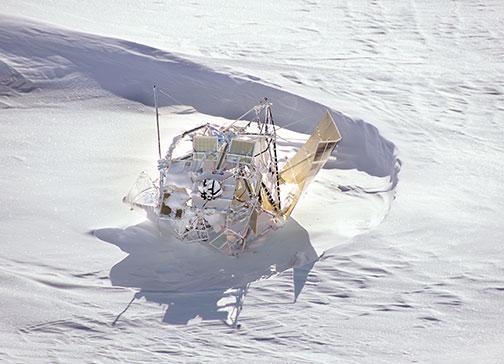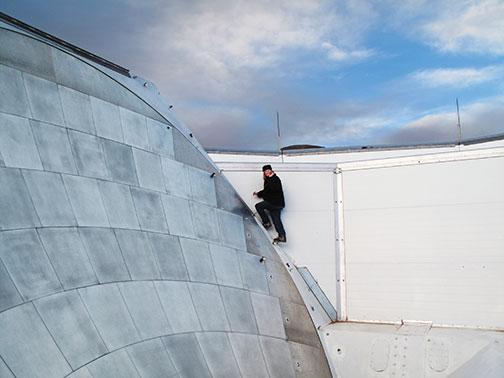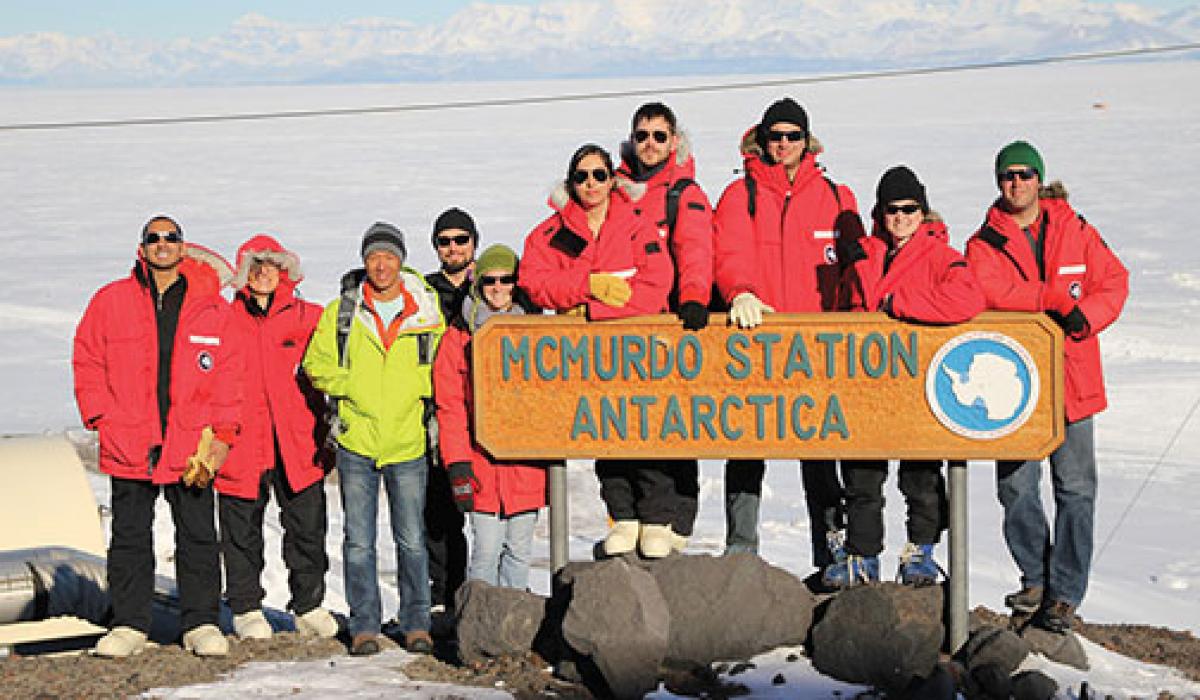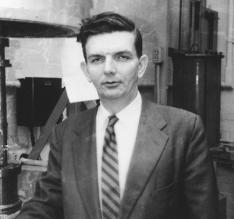The year 2015 started with very good news for Princeton professors and graduate students who specialize in cosmology, the study of the origin and evolution of the universe. On New Year’s Day, a huge, helium-filled balloon lifted a three-ton scientific instrument high above the ice of Antarctica. For the next 16 days, the instrument known as SPIDER — the Suborbital Polarimeter for Inflation, Dust and the Epoch of Reionization — drifted through the stratosphere at an altitude of more than 20 miles, moving in a wide arc around the South Pole. At McMurdo Station, the biggest Antarctic research center, a team led by Princeton physicist William C. Jones ’98 anxiously monitored the instrument’s progress.
As SPIDER floated over the continent, its six telescopes painstakingly measured the cosmic microwave background (CMB), the ancient radiation that cosmologists love to study because it holds so many clues to the history of the universe. By Jan. 17, though, the instrument had run out of the cryogenic fluids that kept its detectors cold enough to observe the faint microwaves. SPIDER was more than 1,000 miles from its launch point, and the fickle circumpolar winds weren’t bringing it back to McMurdo; instead, they were pushing it north, toward the Antarctic Sea. So the researchers radioed a signal that detached the instrument from its balloon and sent it parachuting down to the icy wastes of Ellsworth Land, in the western part of the continent.
Then the race began. SPIDER had collected an enormous amount of data, too much to be sent to the researchers by radio, so the digital records of the CMB measurements had to be retrieved from the instrument. But the landing site was far from any of the U.S. stations in Antarctica, and time was running short; within a few weeks, the 24-hour daylight of the continent’s summer would give way to the perpetually dark Antarctic winter. After waiting a week for bad weather to lift, the British Antarctic Survey came to the rescue Feb. 4 when it sent a twin-engine turboprop to SPIDER’s remote landing site to recover the precious hard drives and solid-state drives holding the collected data. The instrument itself would have to remain on the ice for the winter, but because it was designed to withstand the extreme cold of the stratosphere, Jones and his fellow researchers believe SPIDER would survive the long night and fly again.

SPIDER’s results may shed light on one of the biggest questions in all of science: What created our universe 13.8 billion years ago? In March 2014, a feud erupted in the tight-knit world of cosmology when researchers operating another microwave telescope in Antarctica — a ground-based instrument at the South Pole called BICEP2 — claimed they had observed signals in the CMB that supported the theory of inflation, a hypothesis developed in the 1980s to explain what could have triggered the Big Bang. But other scientists swiftly disputed the claim, with several of Princeton’s cosmologists among the skeptics. The observed signals, they argued, didn’t originate in the early universe; instead, they came from the interstellar dust in our Milky Way galaxy, which the cosmic microwaves had to pass through on their way to Earth.
Over the following months the BICEP2 researchers continued to analyze their observations and compare them with measurements made by the Planck spacecraft, which had observed the CMB from deep space between 2009 and 2013. In their final analysis, released in late January, the researchers concluded that the skeptics were largely right: The BICEP2 data offered no strong evidence for inflation because galactic dust could have caused the suspect signals. But the lasting lesson of the Great Dustup of 2014 was that scientists need better surveys of the CMB to answer the big questions of cosmology.
Princeton has been at the forefront of CMB research ever since the cosmic microwaves were discovered half a century ago. The radiation was emitted very early in the history of the universe, a mere 380,000 years after the Big Bang started. At that time, the dense primordial soup of matter and radiation had expanded and cooled just enough to allow the speeding electrons and protons to form atoms of hydrogen. Because there were no more charged particles to scatter the radiation, it began to travel across the cosmos, propagating in all directions. As the universe continued to expand, the radiation’s temperature dropped and its wavelength stretched until it became a faint microwave haze. If you’re old enough to remember the rabbit-ear antennae of broadcast television, you’ve probably seen the CMB: When the TV was tuned between channels, about 1 percent of the static on the screen came from cosmic microwaves.
According to Jim Peebles *62, professor emeritus in Princeton’s physics department, the University’s dominance of cosmology was “an accident of history” that began with the hiring of Robert Dicke ’39, who had worked to develop radar during World War II. In the 1960s Dicke set out to discover cosmic radiation using a microwave receiver similar to the ones he’d designed for wartime use. He enlisted the help of three younger faculty members — Peebles, David Wilkinson, and Peter Roll — but before they could start the experiment, Dicke got a call from Bell Labs researcher Arno Penzias. He and co-worker Robert Wilson had detected a puzzling microwave signal using a radio antenna in nearby Holmdel, N.J., and they were trying to find out where it came from. After getting off the phone, Dicke reportedly told his younger colleagues, “Boys, we’ve been scooped.”
Nevertheless, Dicke’s team achieved the second clean detection of the CMB, and over the following decades Princeton researchers made ever more precise observations of the radiation. Although the intensity of the cosmic microwaves seemed remarkably isotropic — their temperature appeared to be the same in every part of the sky — theorists expected to find small variations, called anisotropies. They assumed that the primordial soup of the early universe had to be slightly denser in some spots than in others; that was the only way to explain the later formation of stars and galaxies and galactic clusters, which must have coalesced from the denser areas. And the cosmic microwaves emitted in those areas had to be slightly hotter than the radiation coming from the emptier spots. Confirmation of this hunch didn’t come until 1992, when the Cosmic Background Explorer satellite measured the tiny temperature variations, which differed by only one part in 100,000 from the average.

A decade later the Wilkinson Microwave Anisotropy Probe — a NASA spacecraft named after the Princeton physicist and CMB pioneer, who died in 2002 — greatly improved the measurements of the microwave-temperature variations. The next generation of Princeton cosmologists, including physics professors Lyman Page and David Spergel ’82, spearheaded the experiment, which produced a full-sky map of the hot and cold spots in the CMB. In this map, which was further refined by the later results from the Planck spacecraft, the universe looks remarkably simple. Its overall geometry is flat, Euclidean. Its density fluctuations are nearly scale-invariant (variations within small regions of the sky look like variations within larger regions) and its temperature differences are Gaussian (the probability distribution of the differences can be plotted as a bell-shaped curve around the average).
But the results also highlight huge gaps in our knowledge of the universe. The data fit cosmological theories only if we assume that just 5 percent of the universe’s mass consists of ordinary matter such as atoms. About 27 percent must be dark matter, hypothesized particles that don’t emit or absorb light but appear to hold galaxies together with their gravity. And 68 percent must be dark energy, a mysterious substance that seems to have a kind of antigravity that is accelerating the universe’s expansion. The fact that scientists haven’t directly observed either dark matter or dark energy is disquieting, to say the least.
What’s more, the current results can’t tell us how or why the cosmic expansion began. The initial observation of the near-uniform density of the early universe posed a dilemma for cosmologists: How did the primordial soup get so smooth? To solve the puzzle, theorists proposed that inflation — a fleeting moment of violent expansion — kick-started the Big Bang. They hypothesized that a so-called inflaton field stretched a microscopic bit of vacuum into a vast, smooth expanse full of energy, literally turning nothing into everything. Over the past 30 years, cosmologists have modified the hypothesis and devised many versions of it, with several positing that inflation actually is a never-ending process that continually produces an infinite number of universes, each with its own properties and physical laws.
But most versions of the theory have something in common: They predict that inflation would have sent gravitational waves rippling across the early universe. Like dark matter and dark energy, gravitational waves haven’t been directly observed, but Albert Einstein predicted that certain kinds of acceleration would generate them. If inflation occurred and produced these waves, they would have stretched and squeezed the primordial soup and left a characteristic signal in the cosmic radiation. Specifically, the radiation would have been polarized — that is, oriented in a particular direction — when it scattered off the charged particles for the last time. Density variations in the cosmic soup also would have polarized the radiation, but primordial gravitational waves would have left a distinctive polarization pattern called B-mode, which would appear as swirls on the CMB maps.
Over the last decade, researchers have built a wide variety of instruments to measure the polarization of the CMB, in part to hunt for evidence of the inflationary gravitational waves. Because water vapor in the atmosphere can interfere with microwave observations, many of the new instruments are located in dry, high-altitude locations such as the South Pole and the Atacama Desert in northern Chile. Princeton physics professor Suzanne Staggs *93 has been involved in operating several generations of CMB detectors positioned near the peak of Cerro Toco, a mountain in the Atacama Desert, at an elevation of 17,000 feet. “I love going there,” Staggs says. “The ground is reddish and very stark, and the sky is unbelievably clear. It’s a beautiful place, and there’s nothing to do there but science.”
The observatory is about an hour’s drive from the town of San Pedro de Atacama, at the end of a dirt road with many hairpin curves. Staggs and her fellow researchers — usually no more than six are there at a time — have set up an office in a double-length shipping container at the site, but more often they’re tinkering with the detectors, getting them ready to make observations and repairing any damaged equipment. For the first few days on the site, the scientists have to adjust to the altitude, but once they become acclimated they can work there for up to 14 hours before heading back to their primitive accommodations in town. “I get mountain euphoria up there, a sense of well-being,” Staggs says. “And that’s a good thing to have when you’re fixing a lot of broken things.”
One of Staggs’ detectors, Atacama B-mode Search, was designed specifically to look for CMB polarization that might have been caused by gravitational waves. It started scanning selected regions of the sky in 2012, but the results from the experiment haven’t been published yet. Staggs’ newest instrument is the Atacama Cosmology Telescope Polarimeter, which is intended to investigate CMB polarization signals caused by other phenomena. These investigations may offer clues to the nature of dark energy. They also may shine some light on the enigmatic Dark Ages of the universe, the period after the emission of the CMB but before the formation of the first stars. (The latter event is sometimes called the Epoch of Reionization because the intense starlight ionized the interstellar hydrogen atoms, converting them back to speeding electrons and protons.)
Other universities have joined the hunt for CMB polarization signals. Also perched on the slopes of Cerro Toco is the POLARBEAR detector operated by researchers from the University of California, Berkeley. Scientists from Columbia University led the EBEX experiment, which employed a balloon-borne detector roughly similar to Princeton’s SPIDER. And although the Amundsen-Scott South Pole Station is one of the coldest and most remote places on Earth, it has become a hotbed of CMB research. In addition to hosting BICEP2 (which was preceded by BICEP1 and soon will be superseded by BICEP3), the research center is home to the Keck Array and the South Pole Telescope, which also are scrutinizing the CMB for signs of B-mode polarization.
The competition among the research groups is usually healthy and mutually beneficial, but the problems with the BICEP2 results illustrated the dangers of striving to be first. Led by John Kovac ’92, a professor of astronomy and physics at Harvard University, the BICEP2 group focused its observations on a patch of sky where they believed the CMB passed through minimal amounts of galactic dust. The researchers reported a surprisingly strong B-mode signal at 150 gigahertz, which is within the frequency range where the cosmic microwaves are the most intense. The observed polarization patterns were at the degree-scale — that is, each pattern sprawled across a chunk of sky about a degree across. (For purposes of comparison, a full moon is about half a degree wide.) At this scale, the B-mode polarization is more likely to be caused by primordial gravitational waves, so the signal was interpreted as evidence for the theory of inflation. The announcement was trumpeted in the newspapers and even spurred talk of a Nobel Prize.
But Princeton’s Spergel didn’t believe it. Riding the train to New York City, he read the research paper by the BICEP2 group and noticed a problem with its estimates of the polarized emissions from interstellar dust. (The tiny particles absorb distant starlight and reradiate the energy as microwaves, and their emissions can get polarized if the dust is aligned by galactic magnetic fields.) The BICEP2 estimates were based on incomplete data from the Planck spacecraft, which measured the CMB polarization at seven microwave frequencies. Working with Raphael Flauger of the Institute for Advanced Study and J. Colin Hill *14, Spergel used more complete data to estimate the polarized-dust emissions within the region observed by BICEP2. Their paper concluded that all of the B-mode signal reported by Kovac and his colleagues could have come from dust.
Princeton cosmologist Paul Steinhardt, who helped to develop the theory of inflation in the 1980s but has become a critic of the hypothesis since then, was also skeptical, because the BICEP2 researchers had looked at polarization at only one frequency in a relatively small part of the sky. “I saw clear problems with their paper from day one,” Steinhardt says. “And there were a number of us here who felt that way. For a while, it was Princeton versus the rest of the world.”
Once cosmologists saw all the data from Planck, it became clear that the rest of the world was wrong. The spacecraft’s CMB maps showed that no part of the sky is free from the polarized-dust emissions. Given the current evidence, it’s impossible to know whether those emissions are drowning out a genuine signal from the moment of creation, or whether that signal simply doesn’t exist. In retrospect, Kovac notes that the BICEP2 paper did include caveats about the uncertainties regarding dust emissions. “The paper we wrote was actually cautious,” Kovac says. “We said the research needs follow-up. But that’s not the way the news was reported.”
The prevalence of dust emissions has a sobering implication for all CMB observers: It might be impossible to detect the polarization signal from inflationary gravitational waves if it’s buried in so much dusty noise. But with all the new data pouring in from so many experiments, most researchers are still hopeful that they will settle the issue one way or another. Even if the inflationary signal is much smaller than the noise, Staggs believes researchers have a chance of teasing it out if they use improved detectors and make comprehensive observations at many frequencies. Kovac, who is involved in both the Keck Array and BICEP3 experiments, argues that the CMB field is more vibrant than ever. “As we add more evidence, the answer will emerge,” he says.
And what if, in the end, scientists find no evidence for ancient gravitational waves? Would that sound the death knell for the theory of inflation? Steinhardt worries that some cosmologists will hang on to the hypothesis no matter what the experiments show. Because theorists can adjust inflation to produce any outcome, he says, it can’t be proven false. As he wrote in an essay for Nature last June: “The inflationary paradigm is fundamentally untestable, and hence scientifically meaningless.” (He offers an alternative, proposing that the Big Bang was really a Big Bounce — see “The Cosmic Apocalypse,” PAW, Feb. 11, 2009.)
Peebles, who has watched cosmology blossom at Princeton since the 1960s, is helping to organize a conference at the University this June called CMB@50. The program will feature a mix of old and new: recollections of pivotal observations from some of the scientists who made them (including Wilson, co-discoverer of the CMB), as well as discussions of future directions in the field. It will be a celebration, Peebles says, and Princeton is the logical place for it. “We’re not a large group here, but we’re influential,” he says. “We had respected physicists, and they attracted more people to do the same thing. It was a historical accident, but a happy accident.”
Mark Alpert ’82 is the author of four science thrillers, including the international bestseller Final Theory. His first novel for young adults, The Six, will be published in July.
Life Among the Stars: Princeton scientists hunt for habitable planets beyond our solar system
Breaking Ground: Simpler tools for cosmic findings
Q&A: Lucianne Walkowicz, Astronomer on Board



